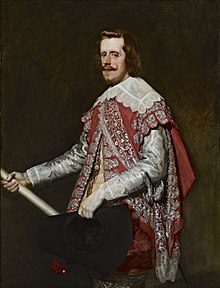| Philip IV | |||||
|---|---|---|---|---|---|
 | |||||
| King of Spain | |||||
| Reign | 31 March 1621 – 17 September 1665 | ||||
| Predecessor | Philip III | ||||
| Successor | Charles II | ||||
| King of Portugal | |||||
| Reign | 31 March 1621 – 1 December 1640 | ||||
| Predecessor | Philip II | ||||
| Successor | John IV | ||||
| Born | 8 April 1605 Royal Palace of Valladolid, Valladolid, Crown of Castile, Spain | ||||
| Died | 17 September 1665 (aged 60) Madrid, Crown of Castile, Spain | ||||
| Burial | |||||
| Spouses | |||||
| Issue among others... | |||||
| |||||
| House | Habsburg | ||||
| Father | Philip III of Spain | ||||
| Mother | Margaret of Austria | ||||
| Religion | Catholicism | ||||
| Signature |  | ||||
Philip IV (Spanish: Felipe Domingo Victor de la Cruz de Austria y Austria,[1] Portuguese: Filipe; 8 April 1605 – 17 September 1665), also called the Planet King (Spanish: Rey Planeta), was King of Spain from 1621 to his death and (as Philip III) King of Portugal from 1621 to 1640. Philip is remembered for his patronage of the arts, including such artists as Diego Velázquez, and his rule over Spain during the Thirty Years' War.
By the time of his death, the Spanish Empire had reached approximately 12.2 million square kilometres (4.7 million square miles) in area but in other aspects was in decline, a process to which Philip contributed with his inability to achieve successful domestic and military reform. He was succeeded on his death by his young son Charles II as King of Spain and in 1640 (with the collapse of the Iberian Union) by John IV as King of Portugal.
- ^ Stradling, R. A. (2002). Philip IV and the Government of Spain, 1621–1665. Cambridge University Press. p. 5. ISBN 9780521323338.